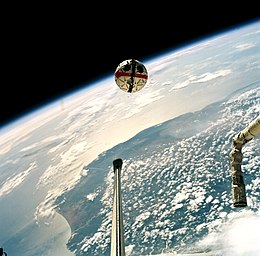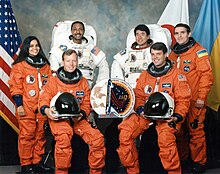 AERCam Sprint, one of the USMP-4 payloads, in flight above Columbia's payload bay | |
| Names | Space Transportation System-87 |
|---|---|
| Mission type | Microgravity research Technology development |
| Operator | NASA |
| COSPAR ID | 1997-073A |
| SATCAT no. | 25061 |
| Mission duration | 15 days, 16 hours, 35 minutes, 01 seconds |
| Distance travelled | 10,500,000 kilometres (6,500,000 mi) |
| Spacecraft properties | |
| Spacecraft | Space Shuttle Columbia |
| Landing mass | 102,717 kilograms (226,452 lb) |
| Payload mass | 4,451 kilograms (9,813 lb) |
| Crew | |
| Crew size | 6 |
| Members | |
| Start of mission | |
| Launch date | 19 November 1997, 19:46 UTC |
| Launch site | Kennedy, LC-39B |
| End of mission | |
| Landing date | 5 December 1997, 12:20 UTC |
| Landing site | Kennedy, SLF Runway 33 |
| Orbital parameters | |
| Reference system | Geocentric |
| Regime | Low Earth |
| Perigee altitude | 273 kilometres (170 mi) |
| Apogee altitude | 279 kilometres (173 mi) |
| Inclination | 28.45 degrees |
| Period | 90.0 min |

 Left to right - in orange: Chawla, Lindsey, Kregel, Kadenyuk; in white: Scott, Doi | |
STS-87 was a Space Shuttle mission launched from Launch Complex 39B of the Kennedy Space Center on 19 November 1997. It was the 88th flight of the Space Shuttle and the 24th flight of Columbia. The mission goals were to conduct experiments using the United States Microgravity Payload (USMP-4), conduct two EVAs, and deploy the SPARTAN-201 experiment. This mission marked the first time an EVA was performed from Columbia. EVAs from Columbia were originally planned for STS-5 in 1982 and STS-80 in 1996, but were canceled due to spacesuit and airlock problems, respectively.[1][2] It also marked the first EVA conducted by a Japanese astronaut, Takao Doi.
- ^ "Shuttle's 'Can Deliver' Crew Grilled". Fort Lauderdale News. Fort Lauderdale, Florida. 17 November 1982. p. 3 – via Newspapers.com.
- ^ "STS-80 Mission Control Center Status Report #27". www.nasa.gov. NASA. 30 November 1996. Archived from the original on 20 January 2022. Retrieved 20 January 2022.